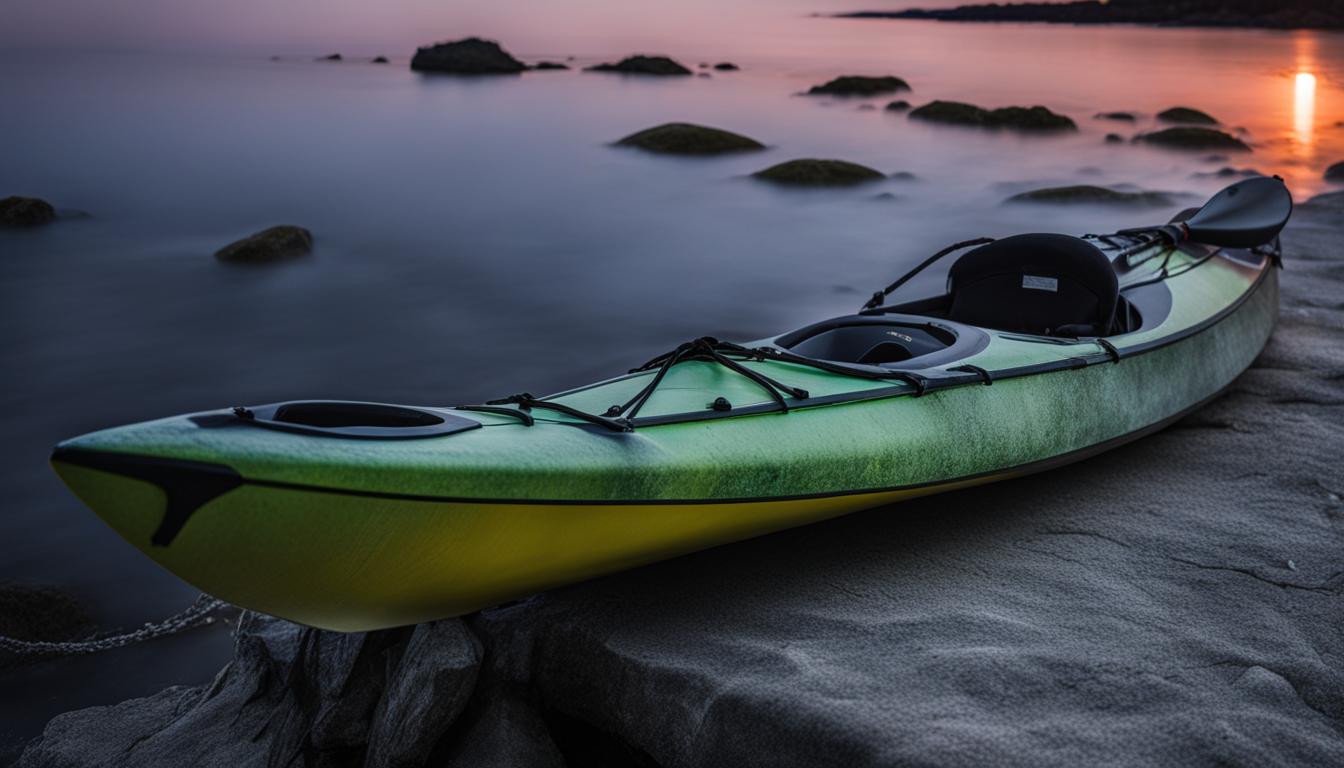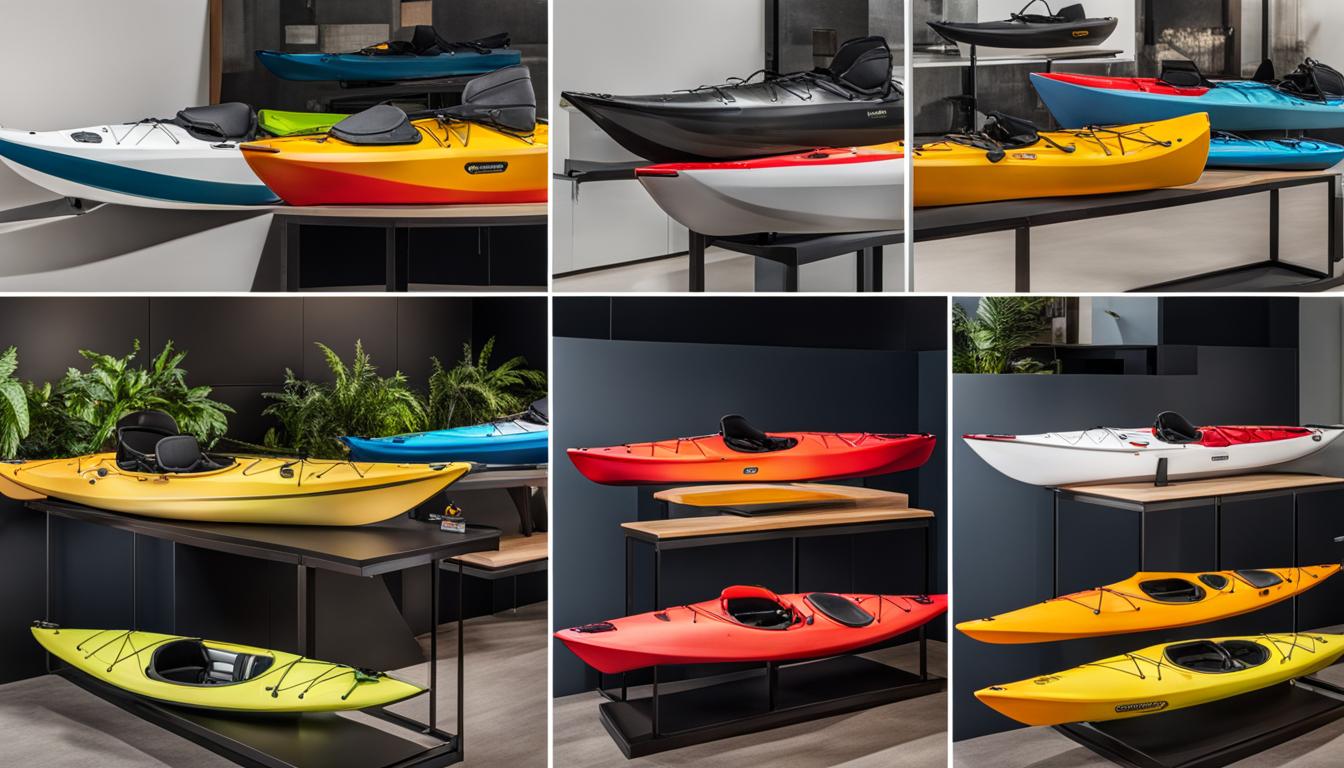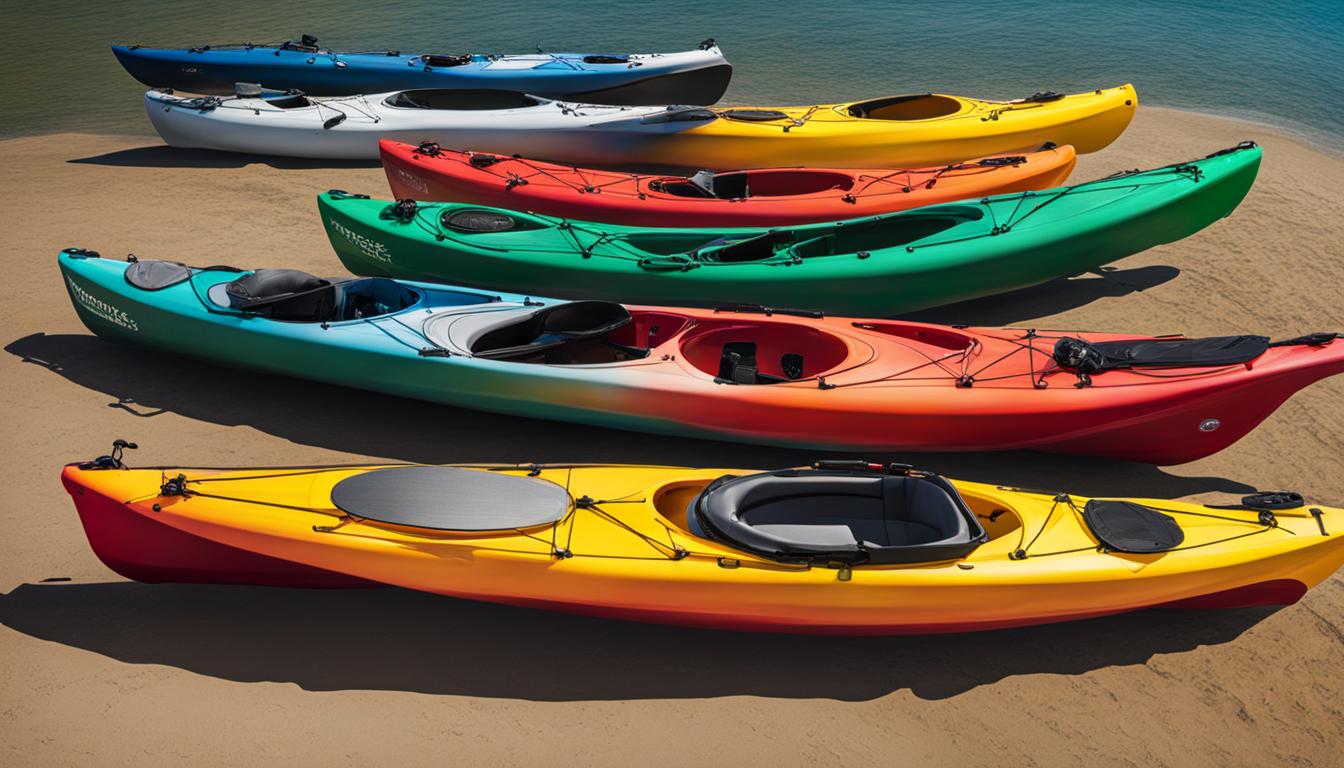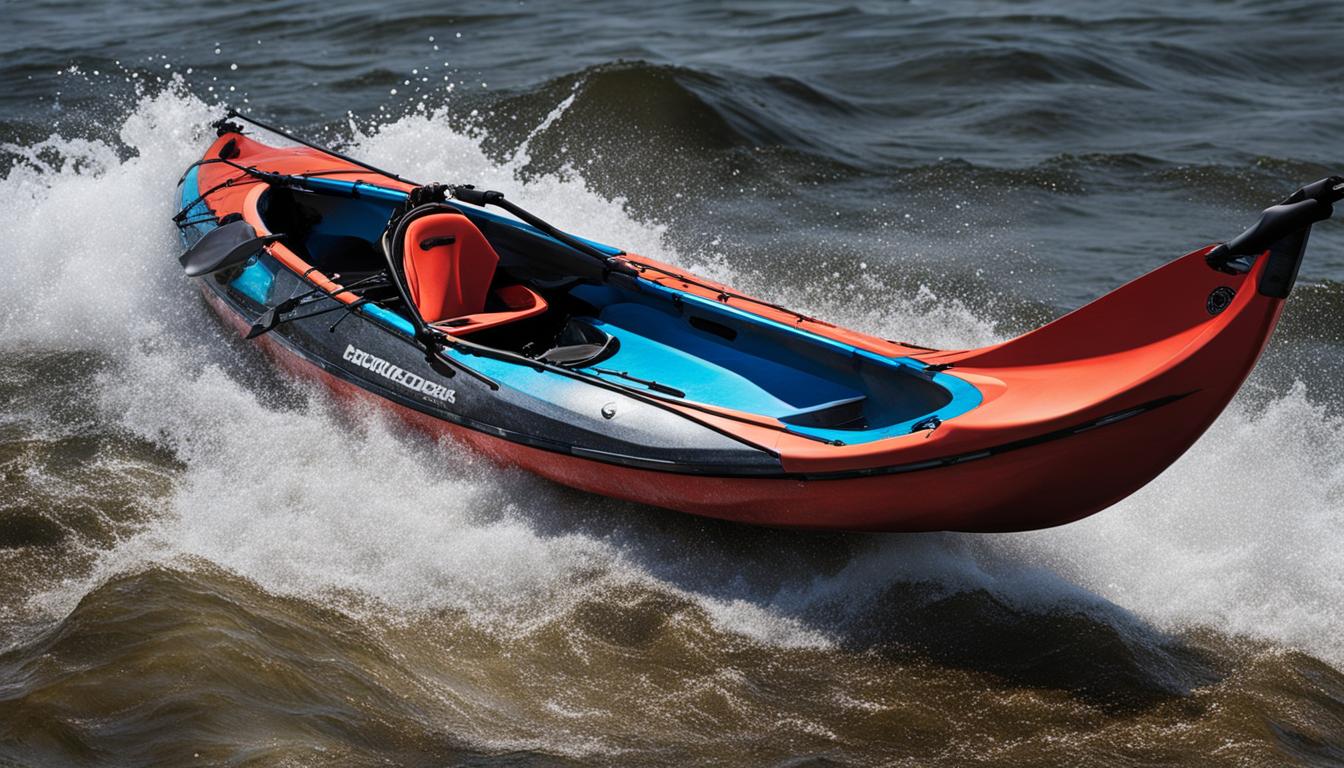When it comes to purchasing a kayak, you want to make sure you’re investing in a quality vessel. It’s crucial to conduct a thorough inspection before making your decision. By following this comprehensive kayak inspection checklist, you can ensure that you’re buying a kayak that meets your needs and will serve you well on your future adventures.
Key Takeaways:
- Inspect the hull, deck, and cockpit for any damages or signs of wear and tear.
- Check the condition of the seat, foot pegs, and rudder (if applicable).
- Test the kayak’s stability and consider the ideal beam width for your height and paddling skills.
- Evaluate the weight, storage space, and compatibility with accessories.
- Take into account the brand reputation and customer reviews.
Guidelines for the Kayak Pre-Purchase Inspection
Before purchasing a new kayak, it is important to thoroughly inspect the vessel to ensure its quality and suitability for your needs. By following this comprehensive checklist, you can make an informed decision and avoid any potential issues in the future.
What to Look for in a New Kayak
- Inspect the hull, deck, and cockpit for any signs of damage, such as cracks or dents. These can affect the kayak’s structural integrity and performance.
- Check the seat, foot pegs, and rudder (if applicable) to ensure they are in good condition and functioning properly. A comfortable and adjustable seat is essential for long trips.
- Test the kayak’s stability by sitting in it and shifting your weight from side to side. It should feel stable and balanced, allowing you to paddle with ease.
- Examine the condition of the paddles, ensuring they are straight, without any bends or cracks.
- Take note of any repairs or modifications that have been done to the kayak. These may impact its performance or resale value.
By conducting a thorough inspection based on these guidelines, you can determine the quality and suitability of a new kayak before making a purchase.
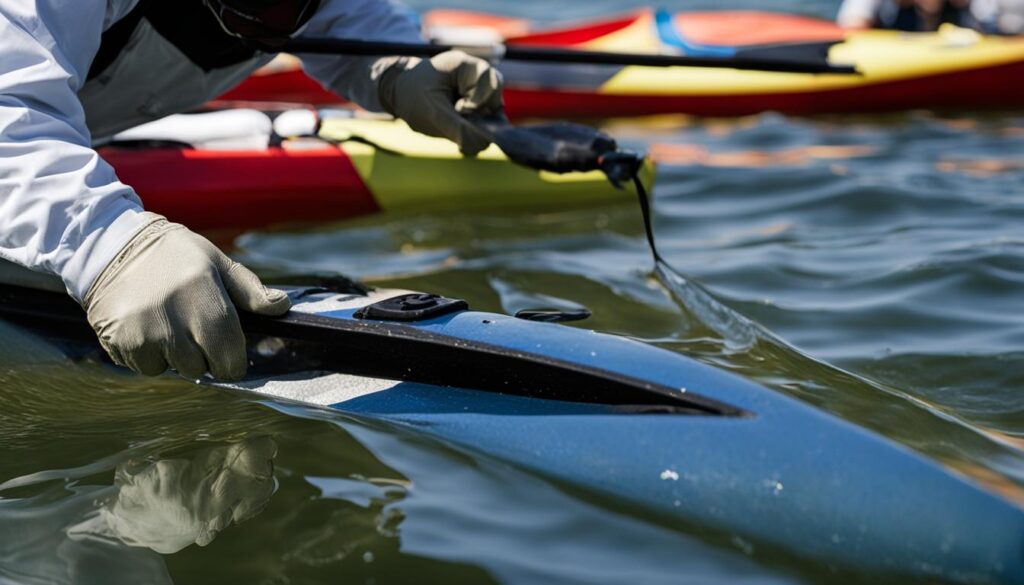
Table: Key Inspection Points
| Inspection Point | What to Look For |
|---|---|
| Hull, Deck, and Cockpit | Cracks, dents, structural damage |
| Seat, Foot Pegs, and Rudder | Condition, adjustability, functionality |
| Stability | Balance, ease of paddling |
| Paddles | Straightness, cracks, bends |
| Repairs and Modifications | Effects on performance, resale value |
Remember, a thorough pre-purchase inspection is essential to ensure that your new kayak meets your expectations and provides a safe and enjoyable paddling experience. Don’t rush the process and take the time to evaluate each of these key inspection points before finalizing your purchase.
New Kayak Inspection Tips
Before purchasing a kayak, it’s essential to thoroughly evaluate its condition to ensure you are making a wise investment. Conducting a pre-trip inspection can help you assess the kayak’s overall performance and identify any potential issues. By following these inspection tips, you can make a well-informed decision and select a kayak that suits your needs.
When assessing a kayak before buying, start by carefully examining the hull, deck, and cockpit for any signs of damage such as cracks or dents. Any structural issues can affect the kayak’s stability and longevity. Additionally, inspect the seat, foot pegs, and rudder (if applicable) to ensure they are in good working condition. A comfortable and functional seating arrangement is crucial for an enjoyable kayaking experience.
Inspecting the kayak before purchasing is like test-driving a car. It allows you to get a feel for its performance and identify any potential red flags that may impact your decision.
Next, evaluate the kayak’s overall stability. One way to assess this is by testing its buoyancy in the water. Sit in the kayak and check if it feels balanced and steady. Additionally, consider the beam width, which is the width of the kayak at its widest point. Narrower kayaks offer greater agility and speed, while wider kayaks provide increased stability. Choose a beam width that matches your paddling skills and preferences.
During the pre-trip inspection, it is also essential to check for any previous repairs or modifications. These can indicate past issues or alterations that may affect the kayak’s performance. Take note of any repairs and assess their quality to ensure they were done properly.
Maintenance Checklist
- Inspect the hull, deck, and cockpit for damage
- Check the seat, foot pegs, and rudder (if applicable)
- Assess the kayak’s stability and beam width
- Look for any previous repairs or modifications
| Inspection Point | What to Look For |
|---|---|
| Hull, Deck, and Cockpit | Cracks, dents, and signs of wear |
| Seat, Foot Pegs, and Rudder | Functionality and comfort |
| Stability and Beam | Buoyancy in the water, width of the kayak |
| Previous Repairs or Modifications | Quality and impact on performance |
By conducting a thorough pre-trip inspection and utilizing the checklist provided, you can confidently assess the condition of a kayak before making your purchase. Remember to take your time, ask questions, and seek professional guidance if needed. Investing in a high-quality kayak will ensure countless enjoyable adventures on the water.
Evaluating Kayak Stability and Beam
When examining a kayak for purchase, it is crucial to assess its stability and beam. These factors play a significant role in determining the overall performance and suitability of the kayak for your needs. Stability refers to the kayak’s ability to remain balanced and steady in the water, while beam refers to the width of the kayak’s hull. Understanding how these attributes impact your kayaking experience is essential to making an informed decision.
Factors to Consider
When evaluating the stability of a kayak, it is important to consider your height and paddling skills. Smaller paddlers may prefer narrower kayaks, as they offer increased maneuverability. On the other hand, taller individuals may benefit from wider kayaks that provide better stability. It is crucial to strike a balance between stability and efficiency to ensure a comfortable and enjoyable kayaking experience.
The beam width of a kayak also affects its stability. A wider beam provides increased initial stability, making it easier to stay balanced when entering and exiting the kayak. However, wider kayaks may sacrifice some speed and efficiency. Narrower beams offer enhanced secondary stability, making them more suitable for experienced paddlers who prioritize maneuverability and speed.
Essential Kayak Inspection Steps
When inspecting a kayak’s stability and beam, consider the following steps:
- Measure the beam width: Use a tape measure to determine the width of the kayak’s hull at its widest point.
- Sit in the kayak: Test the kayak’s stability by sitting in it and shifting your weight from side to side. Observe how the kayak responds and whether it feels stable.
- Consider your height and paddling style: Reflect on your height and paddling skills to determine the ideal beam width for your needs.
- Seek expert advice: If unsure about the appropriate beam width for your specific requirements, consult with knowledgeable kayak experts or experienced paddlers who can offer guidance.
Table: Kayak Stability and Beam Comparison
| Kayak Model | Beam Width | Stability Level |
|---|---|---|
| Model A | 24 inches | High |
| Model B | 28 inches | Medium |
| Model C | 32 inches | Low |
Table: A comparison of kayak stability and beam widths for different models. Please note that these figures are for illustrative purposes only and can vary depending on the specific kayak manufacturer and model.

Additional Considerations for Kayak Pre-Purchase Inspection
When conducting a pre-purchase inspection for a kayak, there are a few additional considerations that can help ensure you make the right choice. In addition to the guidelines mentioned in the previous sections, taking these factors into account will further enhance your assessment and decision-making process.
Weight and Maneuverability
One important aspect to consider is the weight of the kayak. It’s essential to choose a kayak that you can easily handle and transport. Remember to factor in your physical abilities and the intended use of the kayak. A lighter kayak may be more suitable for solo expeditions or shorter trips, while a heavier kayak may offer added stability for fishing or longer excursions.
Storage Space and Compatibility
Another crucial consideration is the available storage space in the kayak. Determine if the kayak has enough room to carry all your necessary gear and equipment. Additionally, consider its compatibility with accessories such as fishing rod holders, dry storage compartments, or anchor systems. These features can greatly enhance your kayaking experience and convenience.
Brand Reputation and Customer Reviews
When making any purchase, it’s always beneficial to research the reputation of the brand and read customer reviews. Look for feedback from other kayakers who have bought the same model or brand. Their insights can provide valuable information regarding the kayak’s durability, performance, and overall satisfaction. Consider reputable brands known for their quality craftsmanship and customer support.
By considering these additional factors during your pre-purchase inspection, you can make a more informed decision and find a kayak that meets your specific needs and preferences.
Conclusion
Conducting a thorough pre-purchase inspection is vital for ensuring that you choose the right kayak for your needs. By following the guidelines and checklist provided, you can make an informed decision and have peace of mind knowing that your kayak is in good condition. With a properly inspected kayak, you can embark on your next adventure with confidence.
Remember to carefully inspect the hull, deck, and cockpit for any damages such as cracks or dents. Check the seat, foot pegs, and rudder, if applicable. Test the kayak’s stability and assess the condition of the paddles. Take note of any repairs or modifications that have been done. These steps will help you identify any potential issues and ensure that you are getting a high-quality kayak.
Additionally, don’t forget to evaluate the kayak’s stability and beam. Consider your height and paddling skills to determine the ideal beam width for your needs. Smaller paddlers may prefer narrower kayaks, while taller individuals may require wider kayaks for better stability. Finding the right balance between stability and efficiency is key for an enjoyable kayaking experience.
Lastly, take into account other factors such as the weight, storage space, and brand reputation. Make sure the kayak is manageable for your needs and has enough storage for your gear. Check if it is compatible with any accessories you may want to use. It’s also worth reading customer reviews to gain insights into the kayak’s performance and durability.
FAQ
What should I look for when inspecting a kayak before purchasing?
When inspecting a kayak before purchasing, it’s important to check for damages in the hull, deck, and cockpit. Make sure to inspect the seat, foot pegs, and rudder if applicable. Test the kayak’s stability and check the condition of the paddles. Also, take note of any repairs or modifications that have been done.
What should I include in a pre-trip inspection for my kayak?
In a pre-trip inspection for your kayak, make sure to inspect the boat and engine for any damages or issues. De-energize and unplug any power cords. Inflate the tubes and check for air leaks. Test the bilge pump and examine the electrical components. It’s also important to make a float plan to let someone know where you are going and your expected return.
How do I evaluate kayak stability and beam?
To evaluate kayak stability and beam, consider your height and paddling skills. Smaller paddlers may benefit from narrower kayaks, while taller individuals may require wider kayaks for better stability. Finding a balance between stability and efficiency is important.
What other things should I consider when inspecting a kayak before purchasing?
In addition to the guidelines mentioned, you should also evaluate the weight of the kayak to ensure it is manageable for your needs. Consider the available storage space and compatibility with accessories. It’s also helpful to take into account the brand reputation and customer reviews.
Why is conducting a thorough pre-purchase inspection important?
Conducting a thorough pre-purchase inspection is vital for ensuring that you choose the right kayak for your needs. By following the guidelines and checklist provided, you can make an informed decision and have peace of mind knowing that your kayak is in good condition. With a properly inspected kayak, you can embark on your next adventure with confidence.

